

Nelson Mandela. Steve Biko. Stephen Bantu Biko (18 December 1946 – 12 September 1977)[3] was an anti-apartheid activist in South Africa in the 1960s and 1970s.
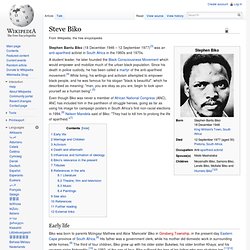
A student leader, he later founded the Black Consciousness Movement which would empower and mobilize much of the urban black population. Since his death in police custody, he has been called a martyr of the anti-apartheid movement.[4] While living, his writings and activism attempted to empower black people, and he was famous for his slogan "black is beautiful", which he described as meaning: "man, you are okay as you are, begin to look upon yourself as a human being".[5] Even though Biko was never a member of African National Congress (ANC), ANC has included him in the pantheon of struggle heroes, going as far as using his image for campaign posters in South Africa's first non-racial elections in 1994.[6] Nelson Mandela said of Biko: "They had to kill him to prolong the life of apartheid.
"[7] Early life Biko was a Xhosa. Marriage and Children Activism. Short Biography: Stephen Bantu (Steve) Biko. Steve Biko was one of South Africa's most significant political activists and a leading founder of South Africa's Black Consciousness Movement.
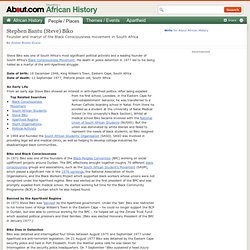
His death in police detention in 1977 led to his being hailed as a martyr of the anti-Apartheid struggle. Date of birth: 18 December 1946, King William's Town, Eastern Cape, South AfricaDate of death: 12 September 1977, Pretoria prison cell, South Africa An Early LifeFrom an early age Steve Biko showed an interest in anti-Apartheid politics. After being expelled from his first school, Lovedale, in the Eastern Cape for 'anti-establishment' behavior, he was transferred to a Roman Catholic boarding school in Natal.
From there he enrolled as a student at the University of Natal Medical School (in the university's Black Section). Biko and Black ConsciousnessIn 1972 Biko was one of the founders of the Black Peoples Convention (BPC) working on social upliftment projects around Durban. Black Consciousness Movement. Steve Biko’s body lying in state.

Source: Bailey’s African History Archives The Crackdown on Black Consciousness Some 35 years ago, on 12 September 1977, the Black Consciousness leader Steve Biko died while in a custody of security police. The period leading up to his death, beginning with the June 1976 unrest, had seen some of the most turbulent events in South African history, the first signs that the apartheid regime would not be able to maintain its oppressive rule without massive resistance.
The Soweto riots were followed by continuous unrest, students and workers in the townships of every province boycotted schools, universities and workplaces, and the regime was hard put to restore the apartheid order. Biko’s death threatened to unleash a new wave of protests, and drew the attention of the world to the situation in South Africa. International outrage now took a more serious turn. Stephen Bantu Biko. Stephen (Steve) Bantu Biko was born in Tylden in the Eastern Province (now Eastern Cape) on 18 December 1946.Biko's early life was modest.
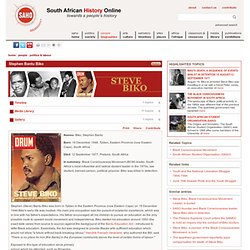
His main pre-occupation was the pursuit of academic excellence, which was in line with his father's expectations. His father encouraged all his children to pursue an education as the only possible route to upward social movement and independence. Biko started his education around 1952 (the exact date varies from source to source) against the background of the Bantu Education Act - introduced to stifle Black education. Essentially, the Act was designed to provide Blacks with sufficient education which would not allow "a future without back-breaking labour. " Hendrik Frensch Verwoerd, who authored the Bill, said "There is no place for him [the Bantu] in the European community above the level of certain forms of labour. " Nelson MANDELA - Lesson plans - Cartoons - Webquests - Videos - Songs. What can we learn from Nelson Mandela to make a difference? - Official WizIQ Teach Blog.
539 Flares Twitter 1 Facebook 532 Google+ 3 LinkedIn 3 inShare3 539 Flares × We teach language to help people communicate.
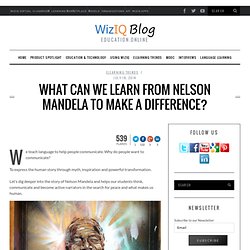
Why do people want to communicate? To express the human story through myth, inspiration and powerful transformation. Let’s dig deeper into the story of Nelson Mandela and helps our students think, communicate and become active narrators in the search for peace and what makes us human. Image credit: Paul Don Smith. Nelson Mandela - Biography - President (non-U.S.), Writer, Civil Rights Activist.
Nelson Mandela became the first black president of South Africa in 1994, serving until 1999.
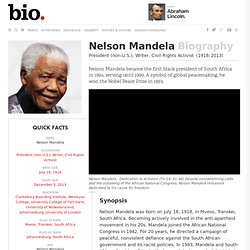
A symbol of global peacemaking, he won the Nobel Peace Prize in 1993. Synopsis Nelson Mandela was born on July 18, 1918, in Mveso, Transkei, South Africa. Becoming actively involved in the anti-apartheid movement in his 20s, Mandela joined the African National Congress in 1942. For 20 years, he directed a campaign of peaceful, nonviolent defiance against the South African government and its racist policies. Nelson Mandela 1918 -2013. Amnesty International paid tribute today to one of the world’s most visionary leaders in the fight to protect and promote human rights, Nelson Mandela.
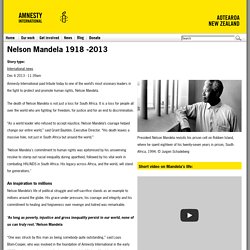
The death of Nelson Mandela is not just a loss for South Africa. It is a loss for people all over the world who are fighting for freedom, for justice and for an end to discrimination. “As a world leader who refused to accept injustice, Nelson Mandela’s courage helped change our entire world,” said Grant Bayldon, Executive Director. “His death leaves a massive hole, not just in South Africa but around the world.”
"Nelson Mandela's commitment to human rights was epitomised by his unswerving resolve to stamp out racial inequality during apartheid, followed by his vital work in combating HIV/AIDS in South Africa. An inspiration to millions Nelson Mandela’s life of political struggle and self-sacrifice stands as an example to millions around the globe. Human dignity, equality and justice. Robben Island. Documentary Nelson Mandela The Fight For Freedom - Documentary BBC. Apartheid in South Africa. Racial segregation in South Africa began in colonial times under Dutch rule.[6] Apartheid as an official policy was introduced following the general election of 1948.
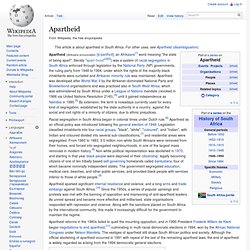
Legislation classified inhabitants into four racial groups, "black", "white", "coloured", and "Indian", with Indian and coloured divided into several sub-classifications,[7] and residential areas were segregated. From 1960 to 1983, 3.5 million non-white South Africans were removed from their homes, and forced into segregated neighbourhoods, in one of the largest mass removals in modern history.[8] Non-white political representation was abolished in 1970, and starting in that year black people were deprived of their citizenship, legally becoming citizens of one of ten tribally based self-governing homelands called bantustans, four of which became nominally independent states.
Precursors of apartheid[edit] In the days of slavery, slaves required passes to travel away from their masters. APARTHEID - ARTICLES, VIDEOS, PICTURES & FACTS. In 1976, when thousands of black children in Soweto, a black township outside Johannesburg, demonstrated against the Afrikaans language requirement for black African students, the police opened fire with tear gas and bullets.

The protests and government crackdowns that followed, combined with a national economic recession, drew more international attention to South Africa and shattered all illusions that apartheid had brought peace or prosperity to the nation. The United Nations General Assembly had denounced apartheid in 1973, and in 1976 the UN Security Council voted to impose a mandatory embargo on the sale of arms to South Africa. In 1985, the United Kingdom and United States imposed economic sanctions on the country. Under pressure from the international community, the National Party government of Pieter Botha sought to institute some reforms, including abolition of the pass laws and the ban on interracial sex and marriage. Nelson Mandela's Life Story. Apartheid. Dossier histoire de l' Apartheid : Sommaire. Colonisée par les Néerlandais au XVIIe siècle et devenue dominion britannique en 1910, l’Afrique du Sud possède déjà un lourd passé de discrimination raciale lorsqu’est mis en place l’apartheid.

Appliquée dès 1948, cette politique, disant favoriser le développement du pays et la préservation des cultures de chaque ethnie, vise surtout à conserver la suprématie blanche. Multipliant les mesures de ségrégation raciale, l’apartheid s’attire de plus en plus les foudres de l’opinion... Apartheid nom masculin (mot afrikaans signifiant séparation) Régime de ségrégation systématique des populations de couleur, en Afrique du Sud. La complexité du peuplement de l’Afrique du Sud explique l’établissement de l’apartheid en système de gouvernement à partir de 1913. Malgré une forte pression intérieure et extérieure, il se maintient jusqu’en 1991. 1.
Le peuplement de l’Afrique du Sud 1.1. Les premiers habitants attestés du territoire actuel de l'Afrique du Sud sont les chasseurs-cueilleurs khoisans (Bochimans et Hottentots). Dès 1652, le Hollandais Jan Van Riebeeck établit le premier comptoir européen en Afrique australe, à Table Bay (aujourd'hui un quartier du Cap), destiné servir d'escale aux navires de la Compagnie hollandaise des Indes orientales.
The History of Apartheid in South Africa. South Africa (see map) is a country blessed with an abundance of natural resources including fertile farmlands and unique mineral resources. South African mines are world leaders in the production of diamonds and gold as well as strategic metals such as platinum. The climate is mild, reportedly resembling the San Francisco bay area weather more than anywhere in the world. South Africa was colonized by the English and Dutch in the seventeenth century. English domination of the Dutch descendents (known as Boers or Afrikaners) resulted in the Dutch establishing the new colonies of Orange Free State and Transvaal.